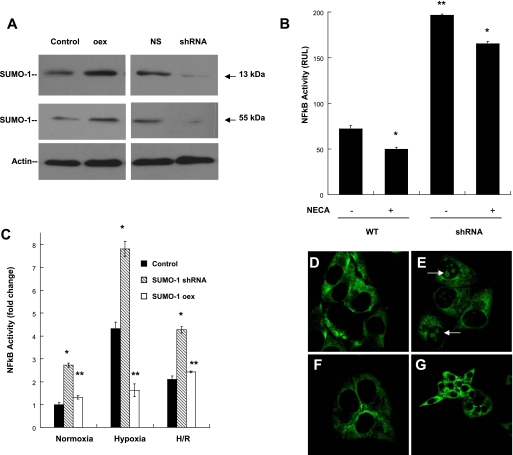FIGURE 4.
SUMO-1 modification of IκBα controls NFκB activation. A, cell models of SUMO-1 overexpression (105%, increase in total SUMO-1 (13 kDa) and 70% increase in SUMO-1/IκBα (55 kDa) (p < 0.001) and knockdown (small hairpin RNA) results in appreciable (90% decrease in total SUMO-1 and SUMO-1/IκBα, p < 0.01) modulation of SUMO-1/IκBα and SUMO-1 protein levels. Nonspecific small hairpin RNA (NS) is shown as control. B, cells transfected with pNRE-Luc were examined for NFκB activity during hypoxia (24 h) in the presence of NECA (10 μm). WT cells demonstrated attenuation of NFκB activity during Ado receptor stimulation (*, p < 0.05). SUMO-1 knockdown cells exposed to same conditions evidence significant increased NFκB activity compared with WT cells (**, p < 0.01). C, expression levels of SUMO-1 regulate NFκB activity at base-line normoxia, during hypoxia and H/R. SUMO-1 knockdown cells demonstrated increase NFκB activity in all conditions (*, p < 0.001); however, the increase was more impressive during hypoxia (∼8-fold). Overexpressing cells showed attenuated NFκB activity in all conditions (**, p < 0.01). D and E, as confirmatory evidence of NFκB attenuation by H/R and adenosine signaling the profile of p65 translocation in normoxic conditions (D) was compared with 24 h of hypoxia exposure (E). Here, a significant nuclear localization was observed as shown by the arrows. In contrast, cells pre-exposed to H/R followed by hypoxia did not evidenced significant p65 translocation (F). G, cells coincubated with NECA demonstrated a predominant cytoplasmic localization of p65, despite hypoxia exposure. WT, wild type.

